How to Can Hot Sauce in Mason Jars
No store bought tomato sauce compares with the season of bootleg. Capture summer in a jar with this seasoned tomato sauce recipe for abode canning.
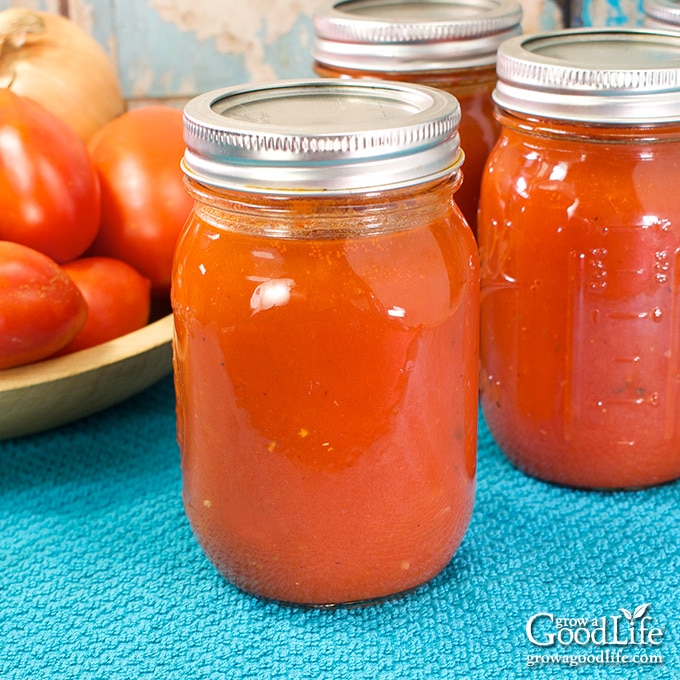
I talk virtually canning tomato sauce a lot here at Grow a Good Life, especially this twelvemonth as I faced the challenge of preserving a bumper ingather. It seems I constantly had baskets of ripe tomatoes to work through for the last two months. Now that the final lycopersicon esculentum harvest is simmering on the stove, I thought it was time to share the tomato sauce recipe and method I use to preserve the majority of my homegrown tomato harvest.
Growing up in an Italian household, the only tomato plant sauce we were enlightened of was the homemade kind made from canned or fresh tomatoes in season. There were no jars of purchased love apple sauce in our pantry. Every bit an developed, I continued the tradition cooking up large batches of homemade tomato sauce and freezing it for hereafter meals.
When I began growing a garden of my own, one of the showtime things I learned to can was tomato sauce from homegrown tomatoes. Eventually, I made information technology my yearly goal to abound enough tomatoes to provide a sufficient amount of canned love apple sauce to last us until the following season.
No store bought tomato plant sauce compares with the flavor of homemade. This is the seasoned tomato sauce recipe and method I use to home can the tomato harvest.
Tips for Canning Lycopersicon esculentum Sauce
Hither are tips for turning freshly harvested tomatoes into bootleg tomato sauce and canning it in shelf stable jars:
Follow a Prophylactic Canning Recipe
If you are canning love apple sauce, is important to employ recipes that are formulated and tested for safe habitation canning. When I make tomato sauce for canning, I follow the seasoned tomato sauce recipe in the Ball Blue Volume Guide to Preserving. This is the closest to the homemade tomato sauce I grew up with.
Use Paste Tomatoes
Use plum type tomatoes for a flavorful and thick sauce. My favorites are Amish Paste, Juliet, Roma, and San Marzano. Plum tomatoes, as well referred to every bit paste tomatoes, are meaty with thick walls and take very little h2o content. Yous can all the same use other types of tomatoes, but it may have longer for the extra h2o to cook out.
Choose good-quality tomatoes with no signs of rot, insect harm, or disease. Don't apply tomatoes from frost-killed vines equally the acidity may accept inverse or these may harbor harmful pathogens that may non be killed during processing.
Remove Skins and Seeds
If you lot are canning tomatoes, you need to remove the seeds and peels in recipes that call for it. So far, there are no tested canning recipes that include the skins. The peels may harbor bacteria, and add unwanted texture to the sauce. Additionally, the peels and seeds may affect the density of the sauce, preventing heat from penetrating properly when processed in a water bathroom canner.
This recipe calls for simmering the tomato sauce with the skins and seeds first, and so straining out the solids from the lycopersicon esculentum pulp. Cooking with the skins and seeds aids in extracting the natural pectin that will help thicken the sauce.
The way I practise the initial cooking depends on the atmospheric condition. If information technology is hot outside, I volition simmer the sauce on the stove as described in the recipe. If the conditions is libation, I roast the vegetables commencement in a 325˚F oven until softened, about an hour. Then add together all the ingredients to a pot and simmer until the sauce has thickened and reduced past half. Roasting adds a lovely, deep tomato flavor to the finished sauce. Exist certain to include all the liquid that releases from the tomatoes.
After the sauce has reduced by one-half, strain with a food strainer or food mill to remove solids, and polish out the sauce. Then return the sauce to the stove, heat to a simmer, and fill the jars.
If you don't have a nutrient strainer, y'all can blanch and peel the tomatoes, and scoop out the seeds earlier making your sauce: See How to Peel Tomatoes for an illustrated, footstep-by-footstep tutorial.
Acidifying Tomatoes
When canning tomatoes, an acid is needed to ensure that the pH is at a level that prevents the growth of C. Botulinum bacteria, which causes botulism. There are two simple ways you lot can utilize to accommodate the acidity when canning tomatoes. Add citric acid or commercial bottled lemon juice:
- Citric acid is my favorite fashion to acidify tomatoes because information technology does not touch on the flavour.
- Bottled Lemon Juice: Bottled lemon juice has been uniformly acidified and then there is a consequent and known acid (pH) level that is needed for safe canning. Don't use fresh squeezed lemon juice considering there is no mode to know the level of acrid in the juice.
Don't Have a Water Bathroom Canner?
You can use a standard large stockpot as long as information technology is tall plenty to cover the jars by two inches of h2o, and at least two more inches of air infinite to preclude boiling water from splashing out. You will need to employ a rack in the lesser of the pot to concord the jars up away from direct heat, so they won't break, and tin can in smaller batches depending on how many jars your pot will concur.
Steps to Making and Canning Lycopersicon esculentum Sauce
This domicile canned seasoned tomato sauce is perfect for tossing with spaghetti and pasta, spreading on homemade pizza, and spooned over chicken or eggplant Parmesan.
Before y'all begin, it may be helpful to review this article on h2o bath canning at the National Center for Home Nutrient Preservation website.
This is a safe caning recipe from the Ball Blueish Book Guide to Preserving for "Seasoned Tomato Sauce." The differences between this recipe and the Brawl seasoned tomato sauce is this recipe has been cut in one-half. I just notice working with a smaller batch of tomatoes much easier to manage since I simply have two big pots to cook downward the sauce.
Seasonings have been adjusted slightly to reduce the amount of table salt, and increase the saccharide to balance the tart flavor of the tomato plant sauce. I besides reduce the sauce by dull cooking it over low heat for a longer period to preserve season rather than cooking over medium-high heat equally indicated in the Ball recipe. Sometimes this takes all twenty-four hours, just the flavor is worth the attempt.
The full and printable recipe tin exist establish at the bottom of this article, only these are the steps for making and canning Italian seasoned tomato sauce:
Pace one: Gather Your Equipment
You'll need:
- Water bath canner with canning rack
- 8 pint sized canning jars, or four quart sized jars
- Canning lids and bands (new lids for each jar, bands tin can be reused)
- Canning tools: jar lifter, canning ladle, funnel, and bubble popper
- Kitchen scale
- Nutrient strainer, food mill, or sieve
- Plus basic kitchen supplies such as a large saucepan, big prep bowls, towels, measuring cup, measuring spoons, large spoon, knife, and a cutting board.
Footstep two: Prepare the Ingredients
Counterbalance and wash tomatoes well under clean, running h2o, and spread out to air dry on towels. Remove the peelings from the onions. Chop and measure out 3 cups of chopped onions. Pare the garlic and mince.
Stride 3: Melt the Sauce
Estrus a large skillet over medium estrus, add together the olive oil, and sauté the onions until softened. Add the garlic and melt briefly until fragrant, and then add the mixture to your saucepan.
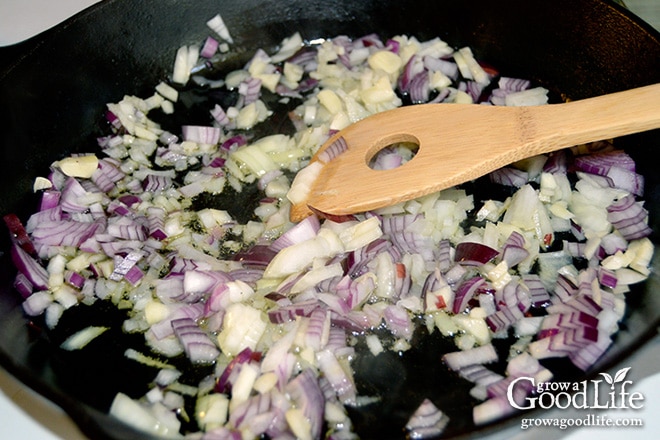
Cut the tomatoes in half or quarters and add to your pot forth with the oregano, bay leaves, blackness pepper, sugar, and blood-red pepper flakes if using. Hold off on the salt for at present and add it to taste at the end.
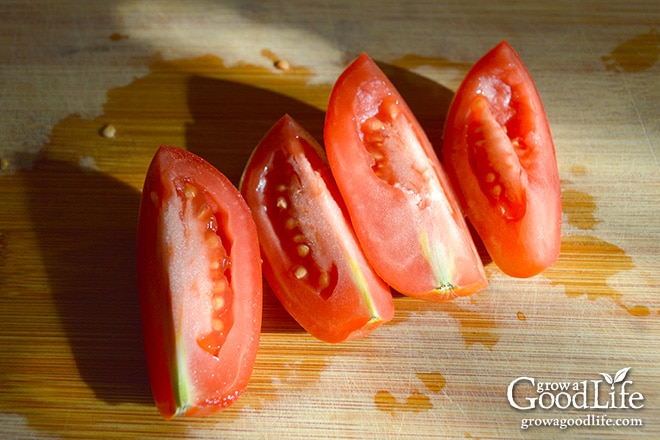
Cover and bring the pot to a simmer over low heat. Vent the cover to let the moisture evaporate, and continue simmering to thicken the sauce until reduced past one-half. The cooking time will vary depending on the amount of moisture in your tomatoes. Stir occasionally to foreclose sticking.
If you are using multiple pots, roughly divide the ingredients for each pot, and combine into 1 pot every bit the sauce cooks downwardly. Utilise your ladle to avert splashing.
One time the volume is reduced by one-half, plow off the rut, and permit it cool slightly so you won't burn yourself when straining.
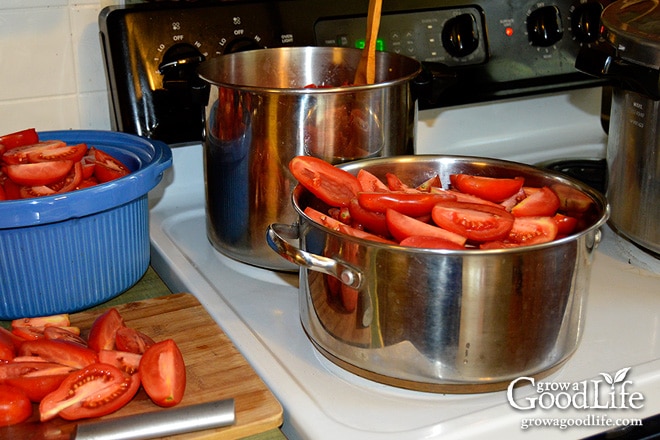
Step iv: Gear up the Canning Equipment
While the sauce is cooling, set up the jars, fix the canner, and organize your piece of work expanse.
Wash your jars, lids, bands, and canning tools in warm, soapy h2o. Rinse well, and gear up the lids, bands, and tools aside to air dry until you are ready to use them.
Jars must be heated before filling to foreclose breakage due to thermal shock. Identify the jar rack into the water bath canner, set the jars upright in the canner, and add together water to cover the jars. Bring the canner to a simmer (180˚F) for 10 minutes, and keep the jars hot until you are fix to fill them.
Follow the manufacturer's directions for preparing the lids. Pre-heating lids is no longer necessary before using, but it is still condom to simmer (180°F) the lids if you want to. Only add them to the canner when you heat your jars.
Step 5: Strain the Sauce
Remove the bay leaves, and run the tomato sauce through a nutrient strainer or food mill to remove skins, seeds, and to smooth out the sauce. Render the sauce to the pot, and bring the sauce dorsum to a simmer (180˚F). Use a make clean spoon and taste the sauce. Add salt and stir in. Taste again. Add more table salt if needed.
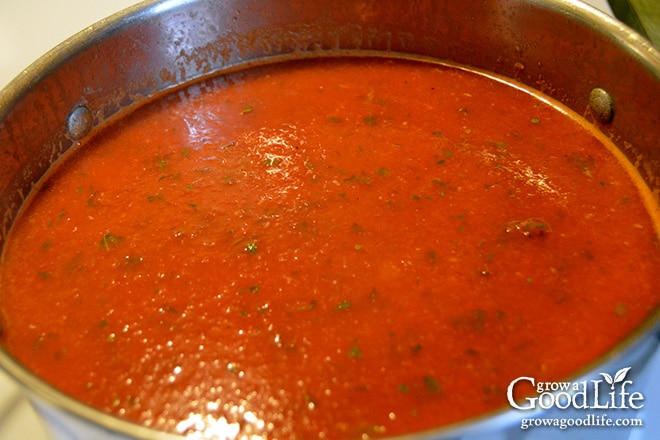
Footstep 6: Tin can the Sauce
Spread a kitchen towel on the counter, and identify the citric acid or lemon juice nearby along with the measuring spoons.
Use the jar lifter to remove a hot jar from the canner, bleed, and place on the towel. Continue the remaining jars in the canner, then they stay warm.
Add citric acid or lemon juice to the jar. For pints, add 1/4 teaspoon of citric acrid, or 1 tablespoon of bottled lemon juice to each jar. For quarts, add 1/2 teaspoon citric acid or ii tablespoons of bottled lemon juice to each jar.
Place the canning funnel on the jar, and ladle hot sauce into the jar while leaving 1/ii-inch headspace. Run the bubble popper through the jar to release any trapped air bubbles.
Wipe the rim with a damp towel to remove remainder. Center a lid on the jar, place the band over the chapeau, and screw it on until fingertip tight. Place the jar back into the canner, and repeat with the rest of the jars.
Adjust the h2o level and then it is covering the jars by several inches, bring the pot to a boil, and process the jars for the times indicated in the recipe beneath. Permit the jars absurd, examination the seals, label and date the jars, and store in a cool, dark location.
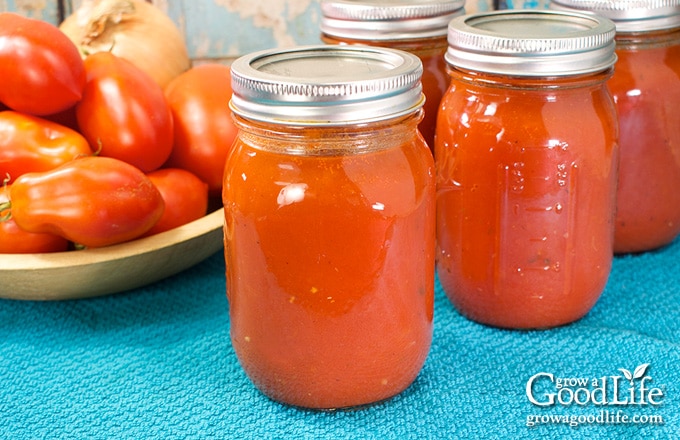
Seasoned Tomato Sauce Recipe
No store bought tomato sauce compares with the flavor of homemade. Capture summertime in a jar with this seasoned love apple sauce recipe for home canning.
Servings sixteen servings
Calories 210 kcal
- 22.5 pounds paste tomatoes
- iii cups chopped onions about 3 large onions
- 6 cloves garlic minced
- 1/four loving cup extra virgin olive oil
- 3 dried bay leaves
- 1 tablespoon dried oregano
- one teaspoons cane sugar
- ane.v teaspoon ground black pepper
- one teaspoons red pepper flakes optional
- citric acid or bottled lemon juice
- 1 teaspoon kosher common salt or more to taste
Set up the Ingredients
-
Weigh the tomatoes, rinse well nether clean, running water, and air dry on a clean towel.
-
Remove the peelings from the onions. Chop and mensurate three cups of chopped onions. Pare the garlic and mince.
Make the Sauce:
-
Heat a large skillet over medium heat, add together the olive oil, and sauté the onions until softened. Add together the garlic and cook briefly until fragrant, then add the mixture to your saucepan.
-
Cut the tomatoes in one-half or quarters and add to the pot along with the bay leaves, oregano, saccharide, black pepper, and ruby-red pepper flakes if using.
-
Bring the pot to a simmer over low heat, and proceed simmering to thicken the sauce until reduced by half. Stir occasionally to forestall sticking.
-
Once the volume is reduced by half, turn off the heat, and allow the sauce cool slightly before straining.
Prepare the Canning Equipment:
-
Wash your jars, lids, screw bands, and canning tools in hot soapy h2o. Rinse thoroughly to remove all suds. Prepare aside to air dry on a make clean kitchen towel.
-
Place the jar rack into water bathroom canner, place jars in the canner, and add together h2o to cover. Bring the canner to a simmer (180˚F) for 10 minutes, and go on the jars hot until you lot are prepare to make full them.
Can the Sauce:
-
Remove the bay leaves, and purée the tomato sauce using a food strainer or food mill to remove skins, seeds, and to smooth out the sauce. Return the strained tomato sauce to the saucepot, and bring back to a simmer (180˚F).
-
Use a clean spoon and taste the sauce. Add salt and stir in. Taste once again. Add more table salt if needed.
-
Spread a kitchen towel on the counter. Place the citric acrid or lemon juice forth with the measuring spoons next to the towel.
-
Use your jar lifter to remove a jar from the canner, drain, and identify on the towel. Keep the remaining jars in the canner and so they stay hot.
-
Add together citric acid or lemon juice to the jar. For pints, add i/iv teaspoon of citric acid, or 1 tablespoon of bottled lemon juice to each jar. For quarts, add ane/two teaspoon citric acid or two tablespoons of bottled lemon juice to each jar.
-
Use your canning ladle and funnel and add the hot sauce to the warm jar leaving 1/2-inch headspace. Swirl your chimera popper through the jars to release air bubbles. Wipe the rim of each jar with a damp towel.
-
Eye a lid on the jar, and spiral on the band until information technology is fingertip tight. Use the jar lifter to identify the jar back into the canner, and repeat with the remaining jars. Try to exit some infinite in between the jars.
-
Once all the jars are in canner, conform the water level to two inches in a higher place the jar tops.
-
Encompass the canner and bring to boil over high rut. One time water boils vigorously, set your timer, and process pints for 35 minutes and quarts for forty minutes at altitudes of less than 1,000 ft. Adjust processing fourth dimension for your altitude if necessary (run across notes).
-
When processing fourth dimension is complete, turn off the rut and allow the canner to cool down and settle for near 5 minutes.
-
Spread a kitchen towel on the counter, and remove the cover by tilting lid away from y'all so that steam does not burn your face up.
-
Use the jar lifter to lift jars carefully from canner and place on the towel. Keep the jars upright, and don't tighten bands or cheque the seals still. Let the jars sit undisturbed for 12 to 24-hours to cool.
-
After the jars have cooled for at to the lowest degree 12 hours, check to be sure jar lids have sealed by pushing on the center of the chapeau. The lid should non pop up. If the lid flexes up and down, it did non seal. Air-condition the jar and use inside a few days.
-
Remove the screw on bands and wash the jars. Characterization, engagement, and shop your jars in a cool, nighttime place. Use inside 12 to 18 months. Refrigerate the sauce once opened and consume inside a few days. Yields virtually 6-7 pint jars or 3-four quarts depending on how much the sauce reduces.
This is a tested safe canning recipe from the Ball Blue Book Guide to Preserving. Altering the recipe may get in dangerous for canning.
All times are at altitudes of less than 1,000 ft. Adjustments must be made for altitudes greater than 1,000 ft:
- Pints at altitudes of ane,001 - 3,000 ft. is 40 minutes, 3,001 - vi,000 ft. is 45 minutes, and above 6,000 feet is 50 minutes.
- Quarts at altitudes of 1,001 - three,000 ft. is 45 minutes, iii,001 - half-dozen,000 ft. is 50 minutes, and in a higher place half dozen,000 feet is 55 minutes.
I am happy to answer any questions, but if you need immediate canning help or answers, please contact your local extension office.
Serving: i cup | Calories: 210 kcal | Carbohydrates: 38 g | Protein: viii g | Fat: vi g | Saturated Fatty: 0.ix k | Sodium: 200 mg | Calcium: 102 mg
This commodity was originally published on October 8, 2015. It has been reviewed and updated with additional information and new photos.
Boosted Canning Information:
- USDA Complete Guide to Home Canning
- Canning Guides at the Ball Website
- half dozen Tips to Prepare for Canning Season
You May Too Like:
- How to Can Whole Tomatoes
- Roasted Roma Pizza Sauce
- Canning Crushed Tomatoes
Good planning is key to a successful vegetable garden
Whether you are new to growing your own food or have been growing a vegetable garden for years, you will benefit from some planning each year. You will notice everything you demand to organize and plan your vegetable garden in my PDF eBook, Grow a Good Life Guide to Planning Your Vegetable Garden.

Source: https://growagoodlife.com/tomato-sauce-recipe-canning/
0 Response to "How to Can Hot Sauce in Mason Jars"
Post a Comment